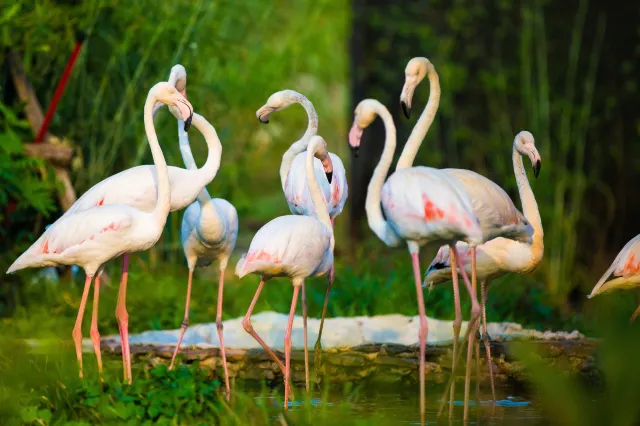Things to Do & See in Waikiki Aquarium
Catalogue
- Introduction of Waikiki Aquarium
- Why Visit?
- 1.Family-Friendly
- 2.Not Expensive
- 3.Features of Hawaiian Submarine
- Things to Do
- 1.See Animal Exhibits
- 2.Sit and Watch Fish Swim at The “Barrier Reef"
- 3.Shopping in The Gift Shop
- 4.Join Annual Events Ke Kani O Ke Kai
- What Cool Exhibits There?
- 1.Jellyfish Exhibits
- 2.Turtle Exhibit
- 3.Hawaiian Monk Seal
- 4.Giant Clam
- Key Information Before Going
- 1.Address
- 2.Opening Hours
- 3.Admission Fee
- How to Get There?
- Attractions Nearby
- 1.Diamond Head Trail
- 2.Honolulu Zoo
Show More
Sitting on the shores of Kapiolani Beach Park, the waikiki aquarium is just a short stroll from the infamous Waikiki Beach. Founded in 1904, it is the second oldest aquarium in the United States and one of the most popular Honolulu tourist attractions. It is also the Coastal Ecosystem learning Centre for the Coastal America Partnership on the Island and is associated with a number of research programs and activities that is centred on the marine life of Hawaii and the Pacific. It is home to more than 3500 different types of marine life out of a total of 500 species and has both aquatic plants and animals. Open on all days, this aquarium presents an incredible opportunity for visitors to get close to marine life and learn all about their behaviour and habitats while doing it all at ticket prices that are within the reach of everybody.
When it opened the Waikiki aquarium was considered state of the art for its time with 35 tanks and 400 marine organisms. In 1955 the aquarium was moved to its current location where further development was carried out with new programs and features being added. The facility has also been active in conservation for marine life and is world renowned for its coral propagation program. Since 2014 it got several new programs which included a sea turtle exhibit that help in the breeding process of the threatened Hawaiian Green Sea Turtles. Perhaps its most famous residents are the two Hawaiian Mon Seals that were rescued as pups. These critically endangered seals are a favourite among the children and the adults who visit the facility regularly.
Anybody who grew up on the Island would be familiar with the waikiki aquarium as a place for family time or school field trips. For tourists, this is the ideal place to learn all about the marine ecosystems around them and in the pacific. Here are the three major reasons to consider:
Located just off the beach the aquarium is a fun place to add to your family day out as a break from all the other places. While it doesn’t sell any food on the spot, you can take your bentos or sandwiches as part of your picnic. Since a number of the exhibits are indoors, you won’t have to worry about the weather.
For a place with so many great exhibits that you can get close to, the waikiki aquarium is surprisingly inexpensive. The tickets are $12 for adults, $5 for children and it’s free for kids less than 3 years of age.
One of the spectacular experiences you can have on your visit to Waikiki is taking an underwater cruise in a submarine. Atlantis Submarines brings you a rare opportunity to experience the natural coral reefs while you glide past them in a comfortable submarine. The outstanding panoramic views allow you to see all kinds of marine life that is built around artificially created coral reefs that have a life sustaining habitat for the region’s marine plants and animals. The ride takes you 100 ft below the water into a 25-acre pristine coral reef with thousands of species of fish, eels and even sharks.

A visit to this vast aquarium would take a good couple of hours of your time to explore completely and learn about all the animals that live there.
The waikiki aquarium is filled with more marine life than you can count! Starting from lower orders of life such as corals, sea anemones, sea cucumbers, star fishes, reef fishes, sharks, turtles and even seals, the aquarium is a living encyclopaedia for your kids. While the marine galleries show you the different ecosystems of the ocean, the outside exhibit called “edge of the Reef” shows you all that you will come across when you go snorkelling. This is also a hands-on experience for the children as they can touch some of the tide pool inhabitants and get a closer understanding of these animals. The pool with Hawaiian monk seals is a great attraction among the children as these seals put on a good show of swimming around the aquarium when the weather is pleasant and they are in the mood to play. At the Amazing Adaptations exhibit you get an exclusive look into some of the stranger of the marine life such as sea horses, sea dragons and pipe fish.
The aquarium features many exhibits that involve coral reefs and marine life in their most natural habitat. The South Pacific Marine Communities is a colourful display that shows multiple marine ecosystems and how the plants and animals interact. The Land Meets the Sea exhibit shoes how mangrove forests on the shorelines create ecosystems for young fish. The Reef Partner exhibit shows the symbiotic relationships between different animals and plants in the reef. One such example being the clownfish (Nemo from the animated movie) and its relationship with sea anemones that offer them shelter. The Lagoon Corals and Reef Predators exhibit are the most favourite among the kids as there are hundreds of colourful fish swimming through the coral reefs and different species of sharks that live among them. The Barrier Reef exhibit which is 21,000 litres tank that features live corals, giant clams and over a hundred different species of fish is the highlight of the gallery.
If you’re looking to take home a piece of your aquarium visit with you, visit their gift shop that’s open every day from 9:00am to 5:00pm. The shop stores a rang or souvenirs, toys, gifts, apparel, jewellery and a lot more that are sure to please you and your children. For those who are more interested in marine biology, the oceans and about aquariums in general, there are a number of books available from basic to advanced levels with a wealth of information in them. Considering the prices in the city, most of the items available are quire affordable and of good quality. There’s a photo op at the start of your trip where an in-house photographer will take the picture of your group with some marine themes. You can purchase these pictures at the gift store.
The Ke Kani O Ke Kai is the aquarium’s popular annual summer concert which is an incredible way to experience the Island’s best talent and food under the stars. Usually held from June to August the concerts are held in series on alternating weeks as per the schedule of the year. It’s a great chance for guests to explore the aquariums under the star-lit skies as they are kept open throughout the evening. They are also encouraged to take their blankets and beach chairs to sit on the front lawn and experience Hawaii’s best entertainers. While it’s a unique way to experience the aquarium, it’s also a major fundraiser for the place. Outside food and beverages aren’t allowed and the parking is limited, therefore it’s best to attend this event through public transport.
The waikiki aquarium has a little over a dozen exhibits to keep you and your kids fascinated for hours. These are the top rated among those:
The Jellyfish exhibit at the Ocean Drifters Gallery is probably the most mesmerizing display in the whole aquarium centre. On any day you can see translucent jelly like organisms undulating in the tanks apparently going nowhere. The smooth semicircular blob like shapes and long flowing tentacles is sure to keep you and your children fascinated. There are a number of species of these including moon jellies, lagoon jellies, Atlantic sea nettles, blue blubbers, white-spotted jellies and more. Since these organisms are seasonal by nature the exhibits are changing throughout the year therefore when you visit on a different season, you can see those varieties which are found in the ocean at that time.
To keep the jelly fish in motion, the tanks have a water flow system that makes them think they are in a current in the ocean just like their natural habitat. They are fed a healthy diet of live plankton and freshly hatched brine shrimp thrice a day. If you happen to visit around a feeding time you’ll get a chance to see how they feed with their tentacles and watch the food move through their stomach chambers.
The recently opened Sea Turtle Exhibit at the waikiki aquarium is a 1000 gallon special exhibit and conservation program to help the threatened Green Sea Turtle species of the Island. The program allows the sea turtle eggs to hatch in captivity where they are raised for about a year protected from predators and other forces of nature which would otherwise kill them. They are kept on a high-fat diet and spend about a year in captivity where they can bulk up enough to be released in a state where they can fend for themselves. While they are in captivity, you can learn all about the turtles, their lifecycle and why conservation is important.
While all the exhibits are sure to captivate your mind Maka onaona and Ho’ailona are sure to capture your heart. The two monk seals have been the top favourites for most of the tourists who visit the aquarium. While on a sunny afternoon you might see them basking in the sun appearing to laze around, they are super active in the morning and evenings and keep the children entertained throughout by zipping around their tanks. Monk seals are solitary by nature and these are males that were raised as pups mostly in captivity because they couldn’t be released into the wild. Monk seals are also the most critically endangered seal species in the world. These seals are confined to the Hawaiian Islands and can found in the uninhabited chain of islands up to 2,000 km away. Although conservation efforts are ongoing by the National Marine Fisheries Service, only about 1,200 of these remain in the wild.
Maka onaona which means “soft or gentle eyes” is the name given to the first monk seal brought to the waikiki aquarium in 1984 from French Frigate Shoals. He was a three week old pup who weighed about 30 kilograms. It is thought that he was abandoned, or orphaned or even weaned early. He wouldn’t have survived on his own if it hadn’t been for the rescuers who brought him to the aquarium. Now with special care and being an adult, he is about 7 feet (2.2 m) long and weighs about 390 pounds (177kg)
Ho’ailona; which means “a sign from the sea“ was rescued and cared for by NOAA scientists 2008 as he was abandoned by his mother soon after his birth. Six months after he was released back into the wild he found to be interacting with humans rather than other seals! Therefore he has to be removed again from the wild and relocated to the more distant island of Nihoa. However on his medical check-up it was found that he was developing cataracts in both the eyes and couldn’t be relocated as he would soon go blind. In 2011 he was brought to the aquarium at the age of three and became a permanent exhibit. Though mostly blind, Ho’ailona has adapted well to his cave and swims quickly and responds to stimuli.
The Giant Clams outdoor exhibit is one that is sure to capture the interest of everyone. Everybody would have seen clams or had them for a meal. While most clams you would know fits in your palm the waikiki aquarium features eight species of giant clams the size of which will truly surprise you. These animals with the iridescent colours and huge size are absolutely magnificent to look at. They are found throughout the Indian Ocean, South Pacific and the Red Sea and get their beautiful colour because of pigments in their tissue and symbiotic association with algae. Though they are all giant, the Tridacna gigas is an absolute beast which can reach lengths over a meter long and weigh up to 250 kg!
Here are some essentials before you head to the waikiki aquarium.
The aquarium is located at 2777 Kalakaua Avenue, on the shoreline in Kapi‘olani Park and is within walking distance from Waikiki Beach.
The Aquarium is open from 9:00am to 4:30pm every day.
It is closed on Christmas Day.
General fee for adults- $12
Fees for children4-12 years old with an adult- $5
Free entry for children under 3 with an adult.
Senior citizens (65+ with ID) and People with disability- $5
In active military duty (with ID) and Kama’aina (with ID proof)- $5
If you’re going by bus, the aquarium can be reached by the bus routes 14, 19, 20 and 22. The Waikiki Trolley which visits many of the attractions can also be taken. The Green Line goes to the aquarium and prices range from $25 to $49 for a 7 day pass for adults and $9 for a child day pass. If you’ve driven to the aquarium, there’s metered parking available on Kalakaua Ave. Free parking in front of the aquarium are limited and are often taken up by those who get there early.
Everywhere from the beaches and the aquarium, the Diamond Head looms large. Basically this geological feature was formed by a series of volcanic explosions and is today a major tourist attraction. From the aquarium it’s a clear sight including people who hike up its trail to reach the summit which is at 750 feet. From a distance the hike looks deceiving and depending on your fitness levels, you can get to the top in about an hour. The views from the top are spectacular and it’s one of the must-visit places in Oahu. The other side of the hike is the beautiful Diamond Head Beach with plenty of surfers and visitors having a great time. For an even better time, stopover at the restaurants at the base of Diamond Head and right on the beach for some fantastic meal with views of the scenery around.
If you started your exploration from the beach side and go to the waikiki aquarium first, the Honolulu Zoo is your next destination to get some more wildlife! This 42 acre setting is part of the larger Kapiolani Park and hosts more than 750,000 visitors every year. The zoo features all types of tropical animals such as lions, giraffes, cheetahs, elephants hippos, rhinos and even Komodo Dragons. The tickets are just as affordable as the aquarium and their gift shop is just as amazing!

Any visit to Waikiki on your trip to Hawaii is not complete without visiting the aquarium and the zoo. This is a fantastic place for you to familiarize yourself with all the marine life before you head out for scuba dives or submarine rides. To get the best out of your visit to Hawaii, book your flight tickets along with the hotel room to get cheap deals. Whether your plan is to visit Hawaii on the best season or during the off-season, an early booking with us is the right way to go about planning your perfect trip.
Trending Travelogues
Popular Trip Moments
Popular Travel Types
Popular Attractions
Popular Ranked Lists
Popular Destinations
Recommended Attractions at Popular Destinations
About











Site Operator: Trip.com Travel Singapore Pte. Ltd.







